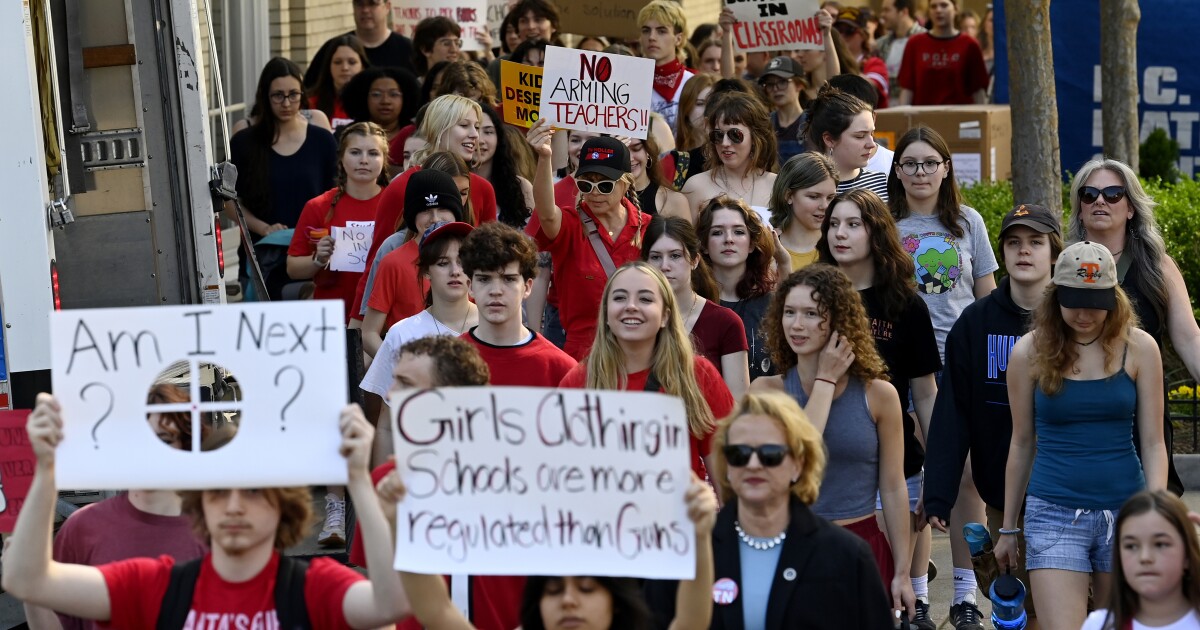A bill that would allow some Tennessee teachers to carry a gun at school is heading to Gov. Bill Lee’s desk.
HB 1202/SB 1325 has drawn heavy attention from parents, teachers, students and law enforcement. The bill would allow specially-trained teachers to carry handguns in their classrooms. Under the bill, parents would not know whether their child’s teacher was armed or not.



The right to bear arms is a constitutionally-guaranteed right; the founders considered it intrinsic to maintaining the system of government.
Clothing isn’t directly, though going from memory, there is some case law on clothing in schools and interaction with the First Amendment.
googles
Yeah. Actually got some bounds on both sides.
https://legal-info.lawyers.com/research/education-law/when-does-the-first-amendment-protect-what-students-wear-to-school.html
Yes, for the purposes of maintaining a well regulated militia.
It’s a shame the Founding Fathers apparently didn’t forsee a future when people would interpret that plain language to include teachers instructing children in a fucking classroom.
What’s the relevance of that? Aren’t there many places in the US where you aren’t allowed to carry a weapon? (Genuine question, I don’t live in the US but I assume that would be the case)
Schools, for one. Also most stats allow private properties to ban firearms onsite. Most states restrict weapons in the government building and courts/such like.
It varies state to state. In some states you need to have a license to carry at all, some require a permit for concealed carry, some allow for businesses to ban firearms(some states it is just a polite request sign with no legal force), some ban carry in parks(national parks or otherwise.).
Nationwide there are certain locations where guns are prohibited like courthouses, government buildings, post offices, political events, etc.
So in most states you can have a permit to carry and have no problems carrying concealed anywhere except the federally prohibited locations. In some states you can carry concealed but must disarm before you go into a business or location with a certain sign. A few states, even with a permit, you can’t use public transit or take a shortcut through a park or go to most businesses if you are in the wrong part of the state. In a couple states you can’t carry a firearm except one that is unloaded and in a case directly between your house and the place that you are lawfully allowed to use it. You can have a magazine that holds more rounds than a certain number of round or a type of firearm legally under state law and then unknowingly enter a city or county that you are not allowed to have that and potentially face legal consequences without the intent to break a law just because a road passes through the boarder of that jurisdiction.
You really have to consider the USA to be 50 different countries, more like the EU, than having consistent laws. You can be totally fine having a loaded AR-15 on you back and cross a legal line and commit a serious crime once you walk a foot into a different jurisdiction.
Schools are one of the places where weapons of any type are prohibited. The only people allowed to have a weapon in schools, usually, are police and military personnel. Doesn’t mean they don’t enter the school but you can get in trouble if your caught.
In my school the Military exception included students who were part of the JROTC drill or rifle teams and currently engaged in an activity associated with that team while in uniform. Drill team could carry their M1s to, during and from drill practice for example.
JROTC stands for Junior Reserve Officer Training Corps. Basically it’s a down sized military academy operated within a normal school, sort of. Mostly you learn survival and field medical skills.
You seem to have specifically missed where it said GIRLS clothing. Girls’ clothing of very heavily regulated, with rules about skirt length, shoulder strap width, and shorts they can wear, with that excuse given that ours to stop them from distracting boys by having bodies. Girls can be sent home if a bra strap shows.
I’d add that I personally am pretty unenthusiastic about school uniforms, though as per the above, uniform mandates do not violate the First Amendment.